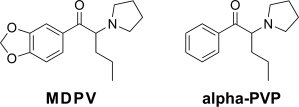A video of a naked guy running around in Florida and ultimately a prior guy who was trying to break into a police station has sparked a mini media storm on the drug “flakka” which is generally found to contain alpha-PVP (alpha-Pyrrolidinovalerophenone). This compounds was placed on Schedule I control by the DEA in March of 2014, so it is illegal to use or posses.
 This drug is structurally very similar to MDPV, as you can see the only thing it is missing is the 3,4-methylenedioxy motif. In the case of methampethamine versus MDMA, this singular structural difference causes very different effects. This does not appear to be the case for MDPV and alpha-PVP.
This drug is structurally very similar to MDPV, as you can see the only thing it is missing is the 3,4-methylenedioxy motif. In the case of methampethamine versus MDMA, this singular structural difference causes very different effects. This does not appear to be the case for MDPV and alpha-PVP.
Marusich et al (2014) showed that alpha-PVP acts pharmacologically as a monoamine transporter blocker with high selectivity for the dopamine transporter over the noradrenaline or serotonin transporters. Alpha-PVP does not get taken up into the neuronal axon terminals (as do many amphetamines and several of the cathinones) and thus does not serve as a monoamine releaser. In this, it is more similar to cocaine than to methamphetamine, albeit with better selectivity than cocaine for blocking dopamine versus serotonin re-uptake. This paper also showed that alpha-PVP was perhaps slightly less potent than MDPV in a mouse locomotor-stimulation test but was able to increase locomotor activity to at least the same amount at a higher dose.
Watterson et al (2014) found that alpha-PVP had a very similar potency to that of methamphetamine in reducing brain reward thresholds using an intracranial self-stimulation reward assay in rats.
Naylor et al (2015) found using a drug-discrimination assay in rats that alpha-PVP fully substituted for methamphetamine in animals trained to distinguish methamphetamine from saline. It appeared to be less potent than methamphetamine in this study.
Our laboratory has been working on a study comparing alpha-PVP with MDPV in an intravenous self-administration assay in rats. [These data are in a manuscript that is currently under review but have also been presented at several academic meetings.] The following work was conducted in separate groups of male rats originally trained to self-administer MDPV or alpha-PVP (0.05 mg/kg/inf in both cases) under a Fixed Ratio 1 contingency. This means each press of the drug-associated lever resulted in one drug infusion.
 After that initial training, the animals were permitted to respond for different infusion doses on different days. During this procedure, each subsequent infusion of drug required an additional number of lever responses during the session. What I show in this figure are the breakpoints achieved in a Progressive Ratio assay . The “breakpoint”, graphed here, reflects the mean number of responses required to obtain the final infusion the rats obtained on a given session. Doses were presented in random order across the groups (Significant differences from the 0.018 mg/kg/inf dose condition are signified by *, from the 0.032 dose by &, from the 0.056 dose by % and differences from the 0.56 dose by #.).
After that initial training, the animals were permitted to respond for different infusion doses on different days. During this procedure, each subsequent infusion of drug required an additional number of lever responses during the session. What I show in this figure are the breakpoints achieved in a Progressive Ratio assay . The “breakpoint”, graphed here, reflects the mean number of responses required to obtain the final infusion the rats obtained on a given session. Doses were presented in random order across the groups (Significant differences from the 0.018 mg/kg/inf dose condition are signified by *, from the 0.032 dose by &, from the 0.056 dose by % and differences from the 0.56 dose by #.).
As should be obvious, MDPV and alpha-PVP generated remarkably similar behavior. The peak of the curves are about the same, indicting that the maximum reinforcing effect of these drugs is similar. The curves also overlap across the entire dose range, suggesting that the potency of the drugs is similar in this procedure. So, from the evidence so far we can conclude that “flakka” is just the next psychomotor stimulant drug to hit the streets. It shows every sign of being very much like MDPV in its effects. Both of these entities are even more like cocaine than they are like methamphetamine, although these differences may be subtle in the real-world of the human drug user.
In the real world, the amount of drug taken and the duration over which an individual has been on a continual-use binge may be more relevant to the sorts of bizarre behaviors that end up on the news than is the specific drug the individual has been consuming.
Leave a comment